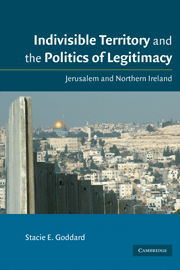The preceding chapters argued that Ulster and Jerusalem became indivisible through comparable political processes. In both cases, legitimation strategies constructed these territories as indivisible: by narrowing the range of legitimate positions, politicians' legitimation strategies constructed Ulster and Jerusalem as indivisible territory, leaving them without the possibility of a negotiated settlement. Ulster's indivisibility sparked almost a century of conflict, ranging from minor spates of violence, such as murders, riots, and sectarian attacks, to organized interstate war in 1919–21, the civil war of 1922–23, the IRAO's “border campaigns” of 1956, and the almost twenty-five years of the Troubles. The unrest, all told, has left 3,624 people dead and 40,000 injured.
In September 2000, as the Israeli-Palestinian peace talks collapsed, the second or “Al-Aqsa” Intifada erupted in Jerusalem. What began as riots at the Temple Mount spread quickly to uprisings in the West Bank and Gaza Strip. Fierce battles followed, as Israeli forces moved to reoccupy Palestinian cities in 2003. Although occasional ceasefires have slowed the violence the truces have been shaky and punctuated by violence, such as in Israel's incursion into the Gaza Strip in 2009. Since 2000, attacks are estimated to have taken the lives of 1,129 Israelis, injuring 6,500, and 4,406 Palestinians, with 31,239 injured.
From 1998 onward, however, Ulster and Jerusalem have appeared worlds apart. Despite ongoing incidents, there is increasing confidence that Northern Ireland is on the road to permanent peace.
